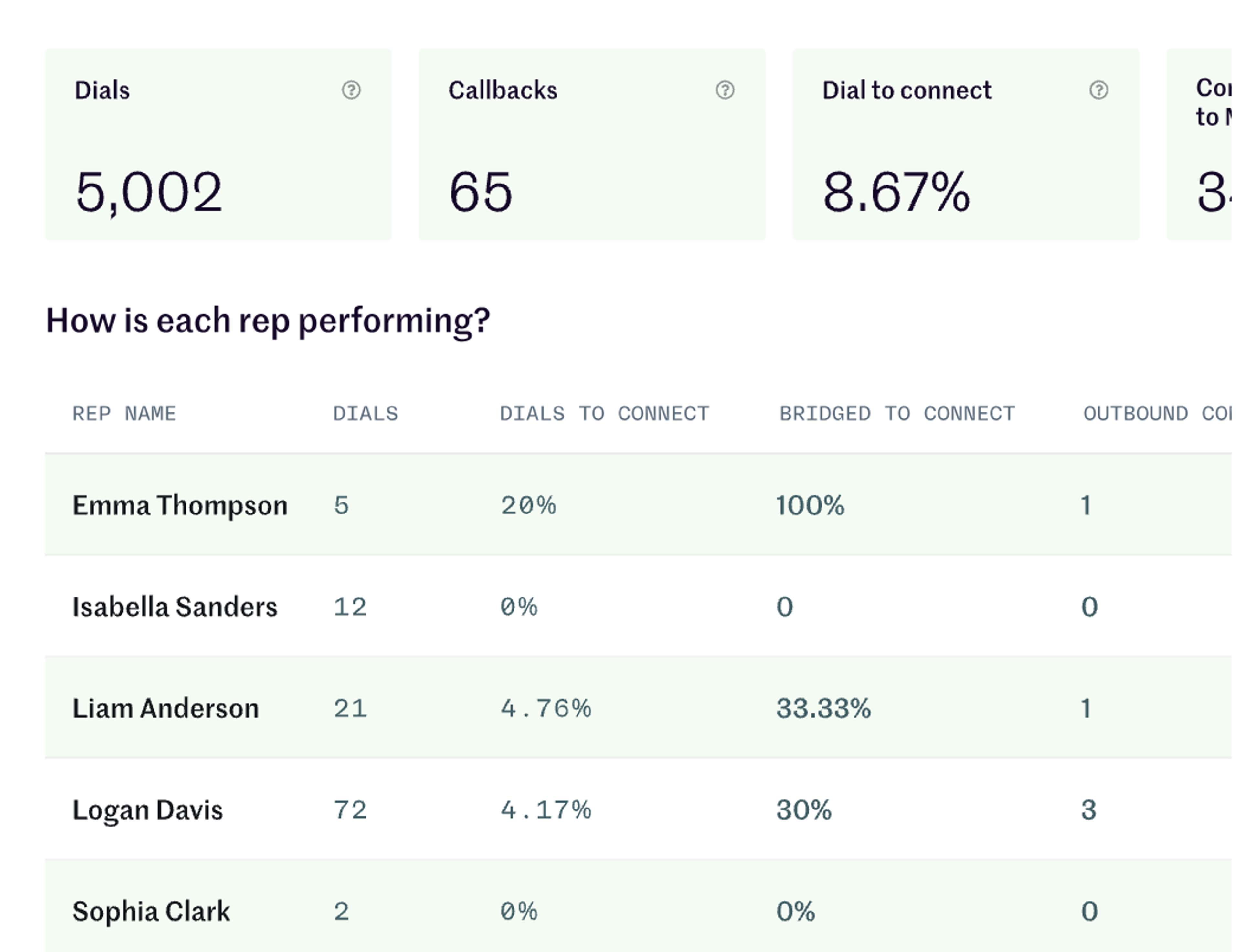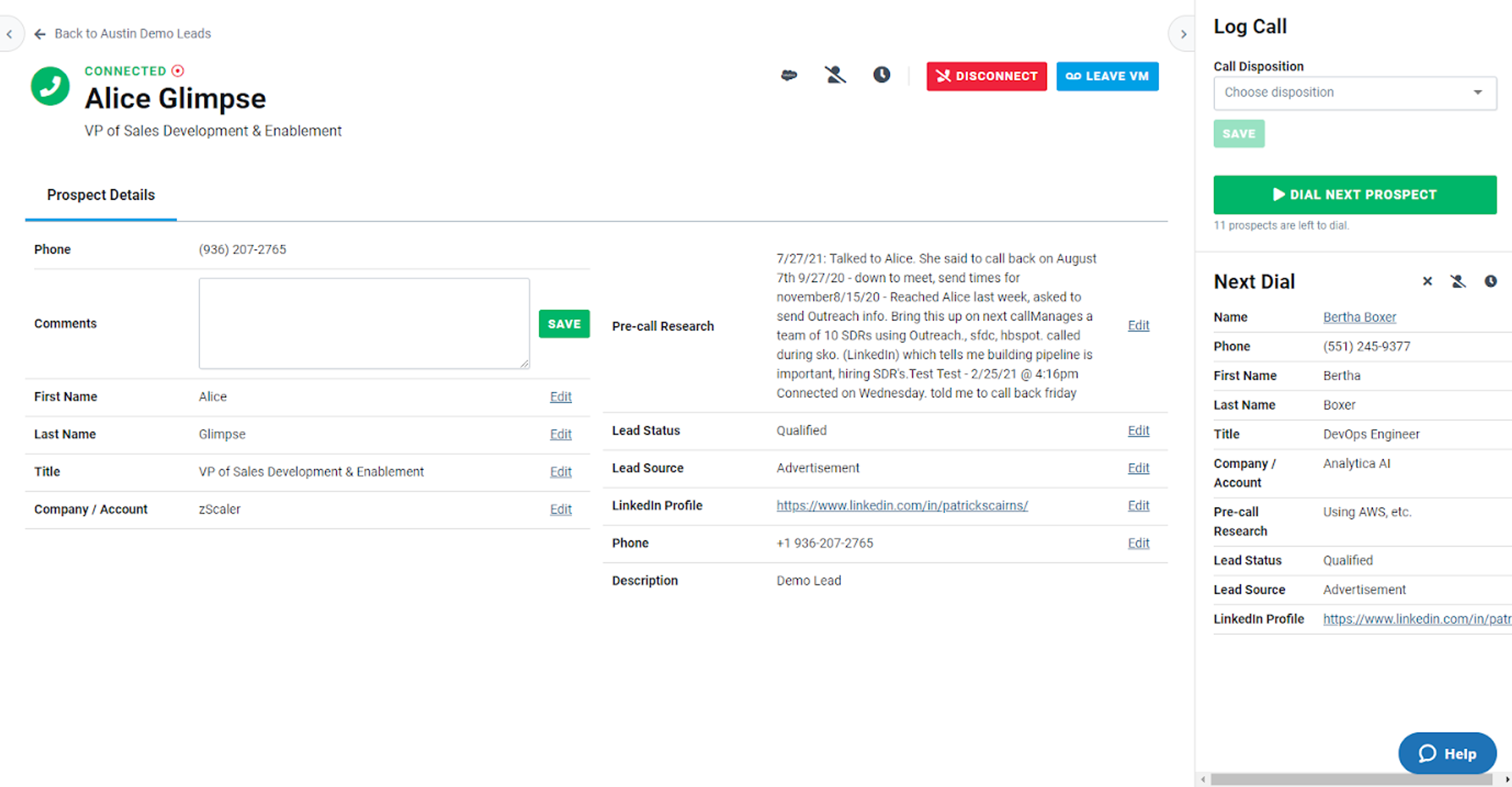How to Establish KPIs for Sales Representatives


According to our 2024 State of Sales Report, what sales productivity means is changing. Businesses are focusing more on results-related key performance indicators than output-focused ones, as new tools reduce the manual workload of sales outreach.
Call volume will always be important. However, for our respondents, the main focus of KPIs is shifting towards metrics like booked meetings (60%) versus traditional activity numbers like sheer call volume (19%).
The question is: How do you find the right performance metrics for your sales team, and how do you effectively implement sales KPIs that grow pipeline and drive revenue?
In this article, we’ll explore how you can effectively implement the right KPIs for your business, considering the role of individual employees and the factors that generate bottom-line revenue.
Create a feedback loop to improve KPIs
Orum integrates with your CRM to ensure all key data is logged and available for effective sales coaching
Request a demo
What factors impact the selection of KPIs for sales teams?
Every company has different objectives and SOPs, so a one-size-fits-all approach to KPIs is never the most effective approach.
These objectives, and consequently KPIs, will often be impacted by the size of your company. For example:
- Startups often prioritize KPIs that lead to rapid market penetration and boost brand awareness. To achieve this, metrics like lead generation rate or customer acquisition cost are ideal for uncovering the effectiveness of outreach efforts.
- SMEs looking to scale will usually look at a more balanced approach to KPIs. New business is essential but this is where you’ll start considering metrics that impact retention rates, conversion rates, and sales cycle length to optimize processes.
- Large enterprises focused on sustained revenue growth will need to measure KPIs like recurring revenue, upsell rates, cross-sell rates, and customer lifetime value. These keep large-scale operations efficient while building on established relationships to maximize revenue.
It’s also important to contextualize KPIs to your industry to create a relevant framework for evaluating sales performance.
Different sectors prioritize different metrics depending on what directly impacts their market, customers, and processes. For example, SaaS (Software as a Service) companies usually base frameworks around monthly recurring revenue rates and customer retention because they work on subscription-based models.
As we explore later in the article, you should also base your KPIs on your team's level of experience.
Six steps to set the right sales KPIs for your team
Let’s look at the practical steps you can take to align your team’s performance metrics with strategic goals, starting with properly defining those goals.
1. Differentiate between short- and long-term sales goals
Setting the right KPIs starts with clearly outlining short-term and long-term sales goals and aligning each KPI with the right objective.
Short-term goals are often focused on monthly or quarterly targets, such as generating more qualified leads, making more calls, or closing more of a specific deal type.
These short-term KPIs help to track immediate performance and contribute to the momentum behind bigger goals. For instance, setting goals for sales reps to book a certain number of meetings or give a specific amount of demos per week drives activity and improves sales velocity.
This will build towards broader, long-term sales goals that span year-long or multi-year periods. These goals might be a market expansion or a specific revenue milestone for the team.
While an agile approach is always part of effective sales, aligning KPIs with both types of business goals will help your sales reps keep their activities connected to the broader vision. This minimizes a disconnect forming between day-to-day tasks and long-term objectives.
2. Identify key metrics that drive pipeline
Key sales metrics are the foundation for properly understanding the health of your pipeline and which optimizations can improve it.
Start by differentiating input and output metrics to gain a top-down view of performance.
Input metrics are the day-to-day activities that generate sales momentum and keep your sales pipeline flowing. These include the number of calls made, emails sent, and demos scheduled.
Input metrics like calls made are common KPIs and with good reason. In our 2024 State of Sales Report, 70% of respondents say most of their pipeline still comes from the phone.
Output metrics, like average revenue per month for a given rep or number of deals closed, reflect the results of input metrics. This can help you spot patterns and optimize KPIs based on what’s working for your top-performing salespeople in your market.
Understanding the relationship between both types is vital. It can help you refine your approach, track individual performance, and forecast future sales outcomes based on activity.
Key pipeline metrics to consider include:
- Sales revenue: The total income from closed deals.
- Leads generated: How many new clients enter the sales funnel.
- Conversion rate: How many leads convert into actual sales.
- Average deal size: An average taken from the mean revenue of each sale.
- Sales cycle length: How long it takes to close a deal.
As Arely Brattin, Senior Sales Development Manager at Orum, explains:
"I use data to track key performance metrics such as call volume, connect rates, conversion rates, and objection win rates...When I look at this on our Orum Performance Dashboard, I am able to see where I need to focus and what I need to focus on for each individual and team level."
For example, if a sales rep struggles with a specific metric, such as objection handling or conversion rates, targeted enablement sessions can be created to address those gaps. By customizing the focus based on these insights, sales leaders can optimize performance and hit their targets.

3. Get buy-in from your sales team
Without transparency, the sales targets you set can feel like simply checking a box. This approach misses the opportunity to create intelligent goals designed to improve performance and generate commission for the reps themselves.
Getting buy-in also has the added bonus of making team members feel like their voices are heard, encouraging them to actively participate in efforts to improve sales strategies.
To do so:
- Use team workshops to generate feedback on proposed KPIs.
- Discuss KPIs in 1:1s to uncover personal concerns and challenges.
- Share the “why” behind your KPI with case studies, examples, and results.
Discover additional insights on how to review sales calls for SDR coaching and get a free sales call report template.
4. Set SMART KPIs
SMART KPIs (Specific, Measurable, Achievable, Relevant, Time-Bound) are designed to keep KPIs clear, realistic, and actionable. Each element adds a layer of structure to the KPI and works as follows:
- Specific. KPIs need to be precise without any room for ambiguity. Instead of vague goals like ‘improve sales in March’, they should specify a clear objective, such as ‘increase conversions by 10%’.
- Measurable. KPIs should provide a tangible measure of success to track. A goal like ‘generate 30 leads per month’ is clearly numerically defined and easy to track.
- Achievable. KPIs should challenge sales reps to perform at their best but they need to be realistic, too. Set goals people can reasonably accomplish with the resources available.
- Relevant. As we’ve covered, KPIs must align with your wider strategic goals. If you’re targeting customer expansion, focus KPIs around customer acquisition rather than reducing sales cycle time.
- Time-bound. Deadlines add structure to KPIs by providing a clear timeframe for achievement.
An example of a SMART KPI for an SME could be ‘increase sales revenue by 15% over the next quarter’. This goal is specific (increase revenue), measurable (by 15%), achievable (based on previous sales data), relevant (aligns with current growth strategy), and time-bound (within the quarter).
It’s also helpful to use contextual benchmarks to define these success criteria. These can include industry standards, historical performance, or even comparable target metrics set by similar companies.
This works as a good failsafe to ensure your KPIs are challenging yet attainable, helping reps stay motivated by giving them realistic outcomes.
5. Ensure KPIs align with sales workflows
KPIs should complement your existing sales process rather than disrupt it.
While 61% of our 2024 State of Sales report respondents said booking meetings was the most important KPI for SDRs in their organization, more developed reps will be assessed on relationship building.
For instance, account executives should be measured on customer retention and CLV (Customer Lifetime Value).
6. Track, measure, and review regularly
KPIs should be reviewed monthly or quarterly. But to properly track and measure them, you’ll need to create a feedback loop that arms you with the information you need to continuously refine your approach; this requires the right set of tools.
Here’s why you need a live conversation platform like Orum:
- Analytics show a bird’s-eye view of team performance with insights such as conversions, callbacks, and connect to meeting.
- The dialer integrates with your CRM to ensure all key data is logged and accessible.
- The call library helps you and your reps coach other salespeople more easily with tags and playlists.
The integrated virtual Salesfloor facilitates real-time feedback from reps to help salespeople hit their targets and KPIs.

Continually adjusting your KPI strategy
Establishing the right KPIs for your business is a dynamic process. As your team shifts and your company grows, you’ll need to continually adjust and align with internal needs and external pressures.
Align KPIs with your team's workflows, continually secure buy-in, and use the right tools to evaluate and refine your approach. That's how to keep implementing KPIs that generate success.
When you partner with Orum, you centralize all data to save time so you reach your KPIs and personal best faster. Integrate with your CRM, get a 360 view of performance, and help give reps real-time feedback.
Create a feedback loop to improve KPIs
Orum integrates with your CRM to ensure all key data is logged and available for effective sales coaching
Request a demo
Frequently asked questions about sales KPIs
What are some sales KPIs examples?
Common examples of effective sales KPIs include outbound call volume, sales revenue, leads generated, conversion rate, average deal size, and customer acquisition cost.
Where can I find a sales KPIs dashboard?
You’ll find KPI dashboards built into many of the top CRM tools like Salesforce and Hubspot. You’ll also find dialing solutions like Orum that track call and conversation data while integrating with your CRM to offer a unified view of key KPIs.





